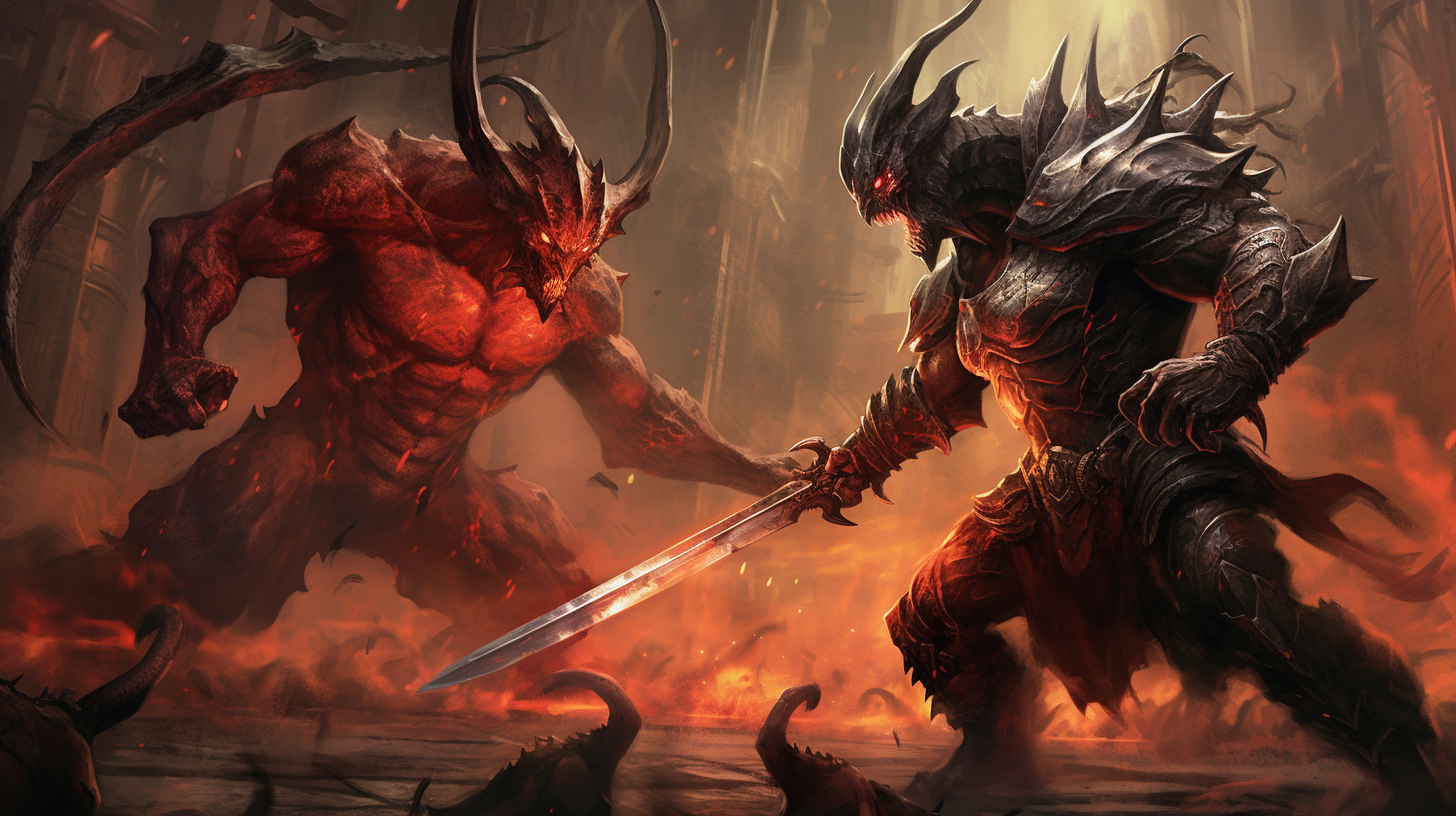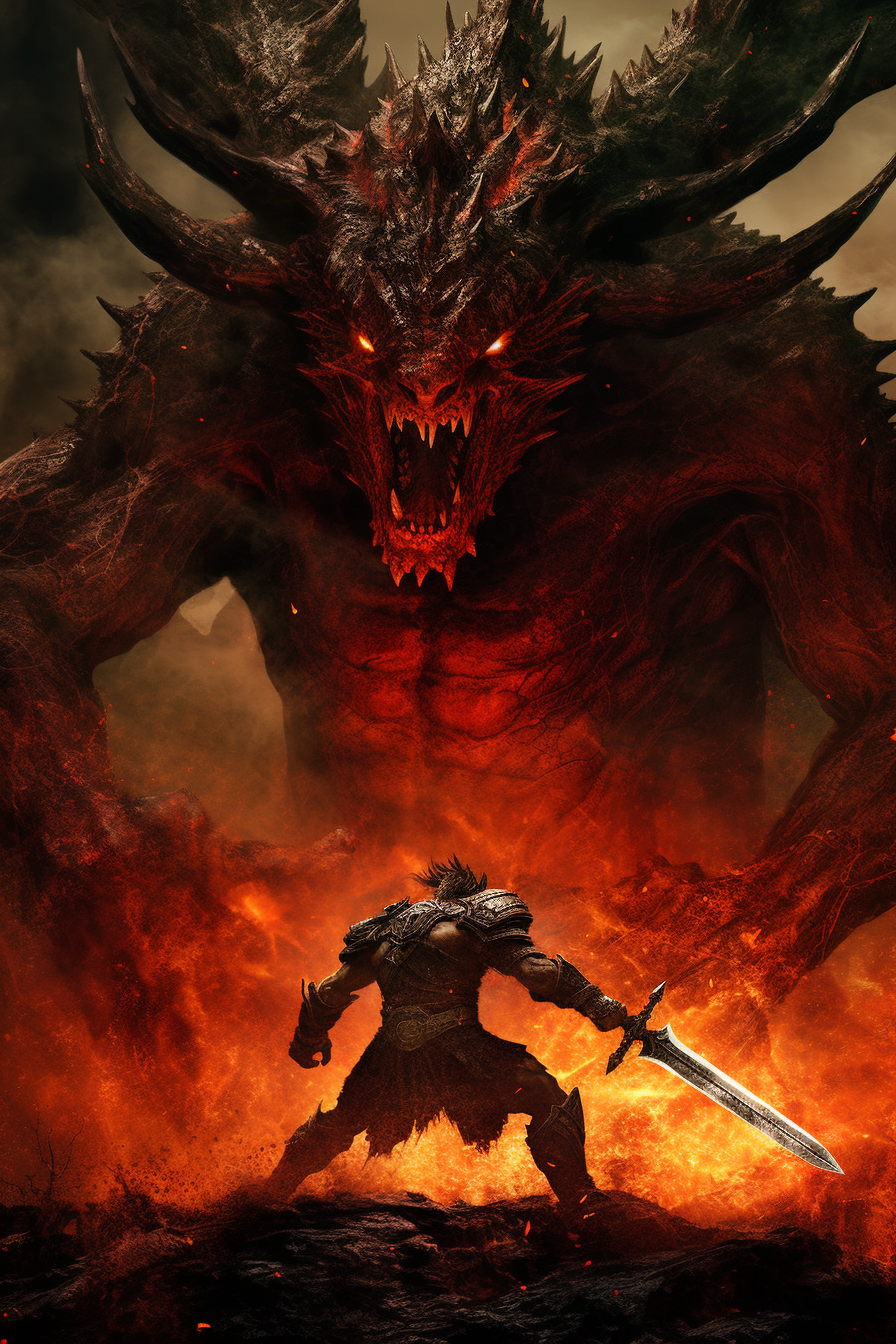Fiend
Fiends: The Dark Mirror of Civilization in the Shadowy Corners of the Multiverse
In the shadowy corners of the multiverse, where the light of goodness scarcely reaches, dwell the malevolent entities known as Fiends. These creatures, born of the Lower Planes, are the very embodiment of evil, each type bearing its own brand of malevolence.
Demons, the anarchic children of the Abyss, are the embodiment of chaos and destruction. They are the storm that seeks to tear asunder all that exists, reveling in the sheer ecstasy of chaos. From the terrifying Balor, wreathed in flame and wielding a whip that crackles with thunder, to the six-armed Marilith, a strategist with a serpent's body and a love for cruelly toying with her foes, demons are a force of unrelenting chaos.
In stark contrast, yet no less terrifying, are the Devils of the Nine Hells. These lawful evil entities are the grand schemers, the puppeteers pulling at the strings of the cosmos. They are the whisper in the ear of the power-hungry, the shadowy figure offering a deal you can't resist, and the iron-fisted ruler seeking to subjugate all under their infernal law. The Pit Fiend, a devil of immense power, commands legions with a strategic mind that rivals the greatest mortal generals, while the seductive Erinyes ensnare the hearts of mortals, leading them down a path of damnation.
Caught in the middle are the Yugoloths, the mercenaries of the Blood Rift. These neutral evil fiends are the wild cards, serving no cause but their own. They are the profiteers of the cosmic conflict known as the Blood War, a ceaseless battle between Demons and Devils. Yugoloths are the mercenaries who stoke the fires of this war, playing both sides to their advantage.
Fiends are more than mere monsters to be vanquished. They are the embodiment of the multiverse's darkest aspects, the living proof of what happens when ambition, desire, and power are left unchecked. They are the ultimate test for heroes, a reminder of the stakes at hand, and the dire consequences should they fail. But they are also a source of intrigue, a chance for heroes to outwit the greatest schemers, to resist the most tempting offers, and to prove that even in the face of the multiverse's greatest evils, there is always hope.
So, whether you're a player standing against these forces of darkness, or a Dungeon Master weaving them into your grand narrative, remember: Fiends are not just foes, but symbols of what we fight against, and sometimes, what we must resist becoming.
Basic Information
Anatomy
Fiends, as creatures of the Lower Planes, possess a wide range of forms and anatomical structures, each uniquely adapted to their infernal environments and roles. Despite their diversity, there are some common characteristics that many fiends share.
Physical Form
Fiends typically have humanoid, beast-like, or monstrous forms, often with terrifying features designed to inspire fear and despair in their enemies. Their bodies are usually solid and corporeal, though they can sometimes become ethereal or incorporeal, particularly when moving between planes.Size and Shape
The size and shape of fiends can vary greatly. Some, like the Imps and Quasits, are small and impish, while others, like the Pit Fiends and Balors, are towering behemoths that can rival dragons in size. Their shapes can range from humanoid to beast-like, often with grotesque and terrifying features such as horns, claws, fangs, and wings.Skin and Scales
Fiends often have tough, leathery skin or scales that serve as natural armor. The color of their skin or scales can range from pitch black to fiery red, sickly green, or even bone white. Some fiends, like the Bone Devil, have exoskeletons that provide additional protection.Temperature Resistance
Many fiends have resistance or even immunity to fire, a trait that serves them well in the infernal heat of the Lower Planes. Some, like the Ice Devil, are adapted to extreme cold environments.Wings and Flight
Many fiends possess wings, allowing them to fly. These wings can take various forms, from bat-like wings to feathered bird-like wings, and even insect-like wings in some cases. Flight gives these fiends a tactical advantage in combat and makes them formidable hunters.Sensory Organs
Fiends typically have highly developed sensory organs. They often have darkvision, allowing them to see in complete darkness—a useful adaptation for the often dimly lit Lower Planes. Some fiends also have truesight, the ability to see through illusions and invisibility.Telepathy
Many fiends have telepathic abilities, allowing them to communicate mentally and even manipulate the minds of others. This makes them highly effective at deception and manipulation.Regenerative Abilities
Some fiends possess regenerative abilities, allowing them to heal rapidly from injuries. This, combined with their natural resistances and immunities, makes them particularly tough opponents in combat. The infernal anatomy and morphology of fiends are as diverse and complex as the fiends themselves. Each type of fiend is uniquely adapted to its role and environment, making them some of the most formidable creatures in the multiverse.Behaviour
Fiend Behavior and Psychology
Fiends, being creatures of pure evil, exhibit behaviors and psychological traits that reflect their malevolent nature. They are cunning, ruthless, and often take pleasure in the suffering of others. However, their behavior can vary significantly depending on their type and rank within the infernal hierarchy.Hierarchy and Power
Fiends exist within a strict hierarchy, with more powerful fiends commanding legions of lesser ones. This hierarchy is often enforced through fear and violence, with power struggles and betrayals being common.Dominance and Submission
Fiends at the top of the hierarchy are typically dominant and aggressive, using their power to control and manipulate those beneath them. Lesser fiends, on the other hand, are often submissive towards their superiors, though they may be cruel and domineering towards those beneath them.Deception and Manipulation
Fiends are masters of deception and manipulation. They are known to lie, cheat, and deceive to achieve their goals, often making false promises and creating illusions to trick their victims.Pacts and Contracts
Many fiends, particularly devils, are known to make pacts and contracts with mortals, offering power, wealth, or other desires in exchange for the mortal's soul. These contracts are often carefully worded to favor the fiend, with dire consequences for those who break them.Sadism and Cruelty
Fiends often take pleasure in the suffering of others. They are known to torment their victims both physically and psychologically, and some even feed on the fear and despair they cause.Torture and Torment
Torture is a common practice among fiends, used not only as a means of punishment but also for their own amusement. They are known to devise creative and horrific methods of torment, taking pleasure in the pain they inflict.Loyalty and Betrayal
While fiends are often loyal to their superiors, this loyalty is usually born out of fear rather than genuine respect or devotion. Betrayal is common in the infernal hierarchy, with fiends constantly scheming to overthrow their superiors and take their place. This is the behavior and psychology of fiends- reflecting their evil nature and the brutal, hierarchical society in which they exist. They are creatures of deception, cruelty, and power, whose actions are driven by their desire for dominance and their delight in the suffering of others.Additional Information
Social Structure
The social structures of fiends are as complex and varied as the fiends themselves. Both demons and devils operate within a strict hierarchy, but the nature of these hierarchies and the relationships between fiends can vary greatly between the two types.
Demons: The Chaotic Hierarchy
Demons, as embodiments of chaos and destruction, have a social structure that is as chaotic as they are. Their hierarchy is based on power and fear, with the strongest demons ruling over the weaker ones through sheer force.Survival of the Fittest
In the Abyss, the home plane of demons, only the strongest survive. Demons constantly fight amongst themselves for power and territory, with the strongest ruling as demon lords. These lords command the lesser demons, who follow out of fear rather than any sense of loyalty or respect.Lack of Cooperation
Cooperation is rare among demons, and alliances are usually temporary. A demon will work with another only as long as it is beneficial, and betrayal is common. This lack of cooperation often hinders the demons' efforts to spread chaos and destruction beyond the Abyss.Devils: The Orderly Hierarchy
In contrast to the chaotic demons, devils operate within a strict and orderly hierarchy. The Nine Hells, where devils reside, is a place of law and order, and this is reflected in the devils' social structure.Ranks and Roles
Every devil has a specific rank and role within the hierarchy, from the lowly lemures to the powerful archdukes. Each rank has specific duties and responsibilities, and devils are expected to perform their roles without question.Promotion and Demotion
Devils can be promoted or demoted within the hierarchy based on their performance. Promotion is a coveted reward, granting the devil more power and authority. Demotion, on the other hand, is a severe punishment, often involving a loss of power and a more demeaning role.Loyalty and Deception
While devils are expected to be loyal to their superiors, deception and manipulation are common. Devils often scheme against each other, seeking to improve their own standing at the expense of others. However, such schemes must be carried out carefully, as failure can result in severe punishment.Civilization and Culture
Common Taboos
Despite their inherently evil nature, fiends do have certain behaviors and actions that are considered taboo within their societies. These taboos, however, are not based on any moral or ethical considerations, but rather on the practical implications and the potential for disruption within their hierarchies.
Demons: Taboos in Chaos
Given their chaotic nature, it's hard to pin down any universally recognized taboos among demons. However, there are certain actions that are generally frowned upon, mainly due to their potential to disrupt the power dynamics.Submission
In the survival-of-the-fittest world of the Abyss, showing submission or weakness is a major taboo. Demons respect power above all else, and any sign of submission is seen as an invitation for others to dominate or destroy the weak.Cooperation
While temporary alliances can occur, long-term cooperation or any form of selfless act is seen as a sign of weakness. Demons are expected to act in their own self-interest, and those who don't are viewed with suspicion and contempt.Devils: Taboos in Order
In the strict hierarchy of the Nine Hells, there are clear taboos that all devils are expected to adhere to.Disobedience
The hierarchy of the Nine Hells is built on obedience. Any form of disobedience, whether it's failing to carry out an order or outright rebellion, is a major taboo. Such actions are seen as a threat to the order of the Nine Hells and are punished severely.Breaking Contracts
Devils are known for their deal-making, and they take their contracts very seriously. A devil who breaks a contract is committing a grave taboo. This not only reflects poorly on the individual devil, but also on the reputation of all devils as reliable deal-makers.Showing Mercy
In the cutthroat world of the Nine Hells, mercy is seen as a weakness. Devils are expected to be ruthless in their pursuit of power, and showing mercy to a rival or an enemy is a major taboo. It's seen as a sign of weakness and a failure to seize opportunities for advancement.
Genetic Descendants
Related Organizations
Related Technologies





Comments